ARCHIVED - Public Health Agency of Canada
 This page has been archived.
This page has been archived.
Archived Content
Information identified as archived on the Web is for reference, research or recordkeeping purposes. It has not been altered or updated after the date of archiving. Web pages that are archived on the Web are not subject to the Government of Canada Web Standards. As per the Communications Policy of the Government of Canada, you can request alternate formats on the "Contact Us" page.
2010-11
Report on Plans and Priorities
Public Health Agency of Canada
The original version was signed by
The Honourable Leona Aglukkaq
Minister of Health
Table of Contents
Message from the Chief Public Health Officer
Section II – Analysis of Program Activities
- 2.1 Strategic Outcome
- Program Activity 1.1 – Science and Technology for Public Health
- Program Activity 1.2 – Surveillance and Population Health Assessment
- Program Activity 1.3 – Public Health Preparedness and Capacity
- Program Activity 1.4 – Health Promotion
- Program Activity 1.5 – Disease and Injury Prevention and Mitigation
- Program Activity 1.6 – Regulatory Enforcement and Emergency Response
- Program Activity 2.1 – Internal Services
Section III – Supplementary Information
Minister's Message
 I am pleased to present the Public Health Agency of Canada's 2010-11 Report on Plans and Priorities. The health of Canadians and their access to a strong and effective health care system are among the highest priorities for the Government of Canada. In my role as Minister of Health, I recognize the important contributions the Agency will continue to make towards these priorities.
I am pleased to present the Public Health Agency of Canada's 2010-11 Report on Plans and Priorities. The health of Canadians and their access to a strong and effective health care system are among the highest priorities for the Government of Canada. In my role as Minister of Health, I recognize the important contributions the Agency will continue to make towards these priorities.
Among the most visible of these contributions are the Agency's efforts in infectious disease prevention and control. The H1N1 flu pandemic dominated the federal health agenda in 2009; however, thanks to years of collaboration and cooperation between the Agency and its many partners, comprehensive pandemic plans were in place. Looking forward, these plans ensure that the Agency will continue to lead the federal response to the H1N1 flu and other pandemics. By employing experience gained from public health events and mass gatherings, such as the 2010 Olympics and the 2010 G8/G20 Leaders Summit, the Agency will continue to strengthen its emergency preparedness.
Collaborative efforts to promote public health and prevent chronic disease are effective ways to reduce the burden on the health care system. The Agency will continue to play a leading role in helping to prevent and mitigate the prevalence of diabetes and heart disease, as well as obesity and other key risk factors. Working closely with stakeholders, the Agency will fund the design and implementation of Canada's first national study on neurological diseases to increase knowledge of these diseases and how they affect Canadians. The Agency will also work to improve the respiratory health of Canadians by advancing the National Lung Health Framework. As well, the Agency will support innovative interventions focused on the mental health of vulnerable Canadians to inform the future development of policies and programs.
With this Report, I am confident that the Agency will demonstrate accountability, efficiency and effectiveness in helping to protect the health and safety of Canadians.
Minister of Health
Message from the Chief Public Health Officer
 Public health is the foundation of a prosperous society. The Public Health Agency of Canada works hand in hand with national and international partners to achieve a vision of healthy Canadians and communities in a healthier world.
Public health is the foundation of a prosperous society. The Public Health Agency of Canada works hand in hand with national and international partners to achieve a vision of healthy Canadians and communities in a healthier world.
Public health often receives the greatest attention during high-profile emergencies such as the H1N1 flu pandemic. Working with partners at all levels, the Agency's response to the pandemic has been multi-faceted: helping secure enough vaccine for every Canadian who wants and needs it; leading surveillance activities; and providing Canadians with information to make well-informed decisions, among many other activities. The Agency will continue to work collaboratively to integrate knowledge and experience gained in leading the Federal response to H1N1 to strengthen preparedness for future pandemics or other emerging infectious disease outbreaks.
The Agency also works to promote and protect the health and safety of Canadians in other areas. Leadership will continue to be demonstrated in health promotion programs for children, youth and seniors to address emerging issues. In accordance with the recommendations made in the Report of the Independent Investigator into the 2008 Listeriosis Outbreak, the Agency will work closely with Health Canada and the Canadian Food Inspection Agency to address systemic challenges in leadership, preparedness, planning for and communicating about food safety issues. As well, by implementing the Human Pathogens and Toxins Act, the Agency will monitor Canadian laboratories to ensure consistency in the safe handling of pathogenic agents and toxins, to protect Canadians from the risks posed by anyone who would intentionally misuse them and to enhance national security.
Through this Report on Plans and Priorities, the Agency has articulated its agenda and will be making progress towards its vision of healthier Canadians and communities in a healthier world.
Chief Public Health Officer
Section I – Overview
1.1 Summary Information
Raison d'être
Public health involves the organized efforts of society to keep people healthy and to prevent injury, illness and premature death. It includes programs, services and policies that protect and promote the health of all Canadians. In Canada, public health is a responsibility that is shared by the three levels of government, the private sector, non-government organizations, health professionals and the public.
In September 2004, the ![]() Public Health Agency of Canada (the Agency) was created within the federal
Public Health Agency of Canada (the Agency) was created within the federal ![]() Health Portfolio to deliver on the Government of Canada's commitment to increase its focus on public health in order to help protect and improve the health and safety of all Canadians and to contribute to strengthening the health care system. The Agency's activities focus on preventing and controlling chronic and infectious diseases, preventing injuries and preparing for and responding to public health emergencies.
Health Portfolio to deliver on the Government of Canada's commitment to increase its focus on public health in order to help protect and improve the health and safety of all Canadians and to contribute to strengthening the health care system. The Agency's activities focus on preventing and controlling chronic and infectious diseases, preventing injuries and preparing for and responding to public health emergencies.
Roles and Responsibilities
The Agency has the responsibility to:
- Contribute to the prevention of disease and injury, and to the promotion of health;
- Provide federal leadership and accountability in managing public health emergencies;
- Serve as a central point for sharing Canada's expertise with the rest of the world and for applying international research and development to Canada's public health programs; and
- Strengthen intergovernmental collaboration on public health and facilitate national approaches to public health policy and planning.
In December 2006, the Public Health Agency of Canada Act came into force, giving the Agency the statutory basis to continue fulfilling these roles.
Strategic Outcome and Program Activity Architecture (PAA)
To effectively pursue its mandate, the Agency aims to achieve a single Strategic Outcome supported by the Program Activity Architecture (PAA) summarized below.
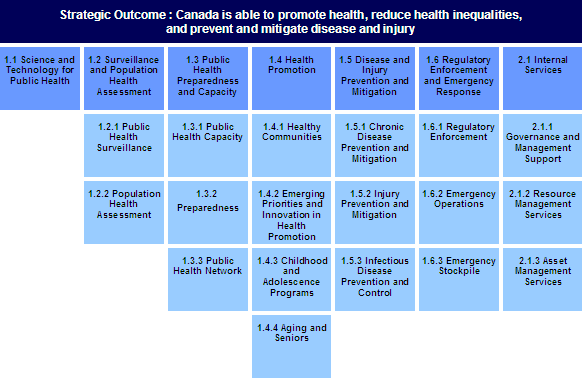
In 2009-10, the Agency continued its work on the implementation of the Management, Resources and Results Structure Policy which included the revision and approval of the Strategic Outcome and PAA as well as the development of an associated Performance Measurement Framework (PMF) and governance structure.
The objectives of this modernization initiative were to: ensure alignment of the Strategic Outcome and the PAA with the Agency's mandate; improve the clarity and measurability of the Strategic Outcome; enhance alignment of Program Activities with the Strategic Outcome; and develop a PMF that would provide more detailed, objective performance measurement information to support the review, assessment and continuous improvement of programs.
PAA Crosswalk
The following crosswalk compares the old to the new PAA and shows the redistribution of financial resources in the 2009-10 Main Estimates. To highlight the importance of research, testing and surveillance in public health, two new program activities were established: Science and Technology for Public Health, and Surveillance, and Population Health Assessment. The new PAA is designed to enable effective planning and reporting at both strategic and operational levels.
| From 2009-10 PAA (columns) | Health Promotion | Chronic Disease Prevention and Control | Infectious Disease Prevention and Control | Emergency Preparedness and Response | Strengthen Public Health Capacity | Internal Services | Total | |
|---|---|---|---|---|---|---|---|---|
| To new 2010-11 PAA (rows) | ||||||||
| 1.1 | Science and Technology for Public Health | - | - | 46.7 | - | - | - | 46.7 |
| 1.2 | Surveillance and Population Health Assessment | 5.9 | 15.0 | 33.0 | - | - | - | 53.9 |
| 1.3 | Public Health Preparedness and Capacity | - | - | 48.8 | 5.6 | 31.1 | - | 85.5 |
| 1.4 | Health Promotion | 183.9 | - | - | - | - | - | 183.9 |
| 1.5 | Disease and Injury Prevention and Mitigation | 2.9 | 41.5 | 117.4 | - | - | - | 161.8 |
| 1.6 | Regulatory Enforcement and Emergency Response | - | - | 10.5 | 19.8 | - | - | 30.3 |
| 2.1 | Internal Services | 1.8 | 3.8 | 4.9 | 1.4 | - | 74.0 | 85.9 |
| Total | 194.5 | 60.3 | 261.3 | 26.8 | 31.1 | 74.0 | 648.0 | |
Planning Summary
Financial and Human Resources
| 2010-11 | 2011-12 | 2012-13 |
|---|---|---|
| 664.8 | 607.6 | 576.3 |
| 2010-11 | 2011-12 | 2012-13 |
|---|---|---|
| 2,590 | 2,583 | 2,535 |
| Performance Indicator | Target |
|---|---|
| Health-adjusted life expectancy at birth | Canada is among the nations with the highest healthy life expectancy at birth |
| Program Activity | Forecast Spending 2009-10 |
Planned Spending | Alignment to Government of Canada Outcomes | ||
|---|---|---|---|---|---|
| 2010-11 | 2012-12 | 2012-13 | |||
| 1.1 Science and Technology for Public Health | 57.0 | 85.0 | 58.8 | 48.3 | Healthy Canadians |
| 1.2 Surveillance and Population Health Assessment | 56.8 | 58.3 | 58.8 | 57.2 | Healthy Canadians |
| 1.3 Public Health Preparedness and Capacity | 88.9 | 104.1 | 72.0 | 68.0 | Healthy Canadians |
| 1.4 Health Promotion | 184.3 | 178.8 | 177.8 | 177.9 | Healthy Canadians |
| 1.5 Disease and Injury Prevention and Mitigation | 423.9 | 115.7 | 118.4 | 102.3 | Healthy Canadians |
| 1.6 Regulatory Enforcement and Emergency Response | 122.9 | 29.5 | 29.6 | 28.5 | Safe and Secure Canada |
| 2.1 Internal Services | 107.6 | 93.4 | 92.2 | 94.1 | |
| Total | 1,041.4 | 664.8 | 607.6 | 576.3 | |
Contribution of Priorities to the Strategic Outcome
The following table outlines four operational and two management priorities and their links to the PAA and Agency plans.
| A1. Managing Public Health Risks to Canadians | Type: Ongoing | Link to Program Activities (PA's): PA 1.1, 1.2, 1.3, 1.5, 1.6 |
Why is this a priority?
Plans for meeting the priority
|
||
| A2. Promoting the Health of Vulnerable Canadians | Type: Ongoing | Link to Program Activities (PA's): PA 1.2, 1.3, 1.4, 1.5 |
Why is this a priority?
Plans for meeting the priority
|
||
| A3. Public Health Capacity | Type: Ongoing | Link to Program Activities (PA's): PA 1.2, 1.3, 1.5, 1.6 |
Why is this a priority?
Plans for meeting the priority
|
||
| A4. Improving Knowledge Dissemination and Use of Best Practices in Public Health | Type: Ongoing | Link to Program Activities (PA's): PA 1.2, 1.3, 1.4, 1.5, 1.6 |
Why is this a priority?
Plans for meeting the priority
|
||
| B1. Achieving Business Excellence | Type: Previously committed | Link to Program Activities (PA's): PA 2.1 |
Why is this a priority?
Plans for meeting the priority
|
||
| B2. People Management | Type: New | Link to Program Activities (PA's): PA 2.1 |
Why is this a priority?
Plans for meeting the priority
|
||
Risk Analysis
The Agency operates within a changing socio-economic environment domestically and globally. Canada weathered the 2007-2009 global financial crisis well; however, impacts were felt in many communities, including rural, remote, and Northern communities where life expectancies may be shorter than that of average Canadians. The Agency has a role to play in helping to mitigate and reduce health inequalities in Canada by improving the health and safety of disadvantaged and vulnerable Canadians.
Countries worldwide are more dependent on one another, which has resulted in higher international migration,, commerce and travel. This trend increases the likelihood of an infectious disease outbreak and the speed of its transmission. The Agency's experience in responding to the ![]() H1N1 pandemic in Canada will provide knowledge and tools to strengthen surveillance, planning, preparedness and response for future pandemics. In 2010-11, the Agency will integrate this expertise to inform improvements and help define a way forward for other public health events.
H1N1 pandemic in Canada will provide knowledge and tools to strengthen surveillance, planning, preparedness and response for future pandemics. In 2010-11, the Agency will integrate this expertise to inform improvements and help define a way forward for other public health events.
Global food supply chains and demand for lower costs result in food products that are sourced from many different countries, not all of which have robust regulatory systems to protect the public from food-borne illnesses. The Agency will continue working with Health Canada and the Canadian Food Inspection Agency to implement measures to address the recommendations made in the ![]() Report of the Independent Investigator into the 2008 Listeriosis Outbreak.
Report of the Independent Investigator into the 2008 Listeriosis Outbreak.
Coordination and capacity among federal, provincial, territorial, regional and local health authorities is of the utmost importance to enable effective management and response to multi-jurisdictional food-borne illness and infectious disease outbreaks. The Agency will continue to coordinate through strategies that include addressing systemic challenges in leadership, preparedness, planning and communication of food safety issues. The H1N1 flu outbreak will also provide insight for continued improvements.
The Agency will continue to enhance emergency preparedness and response capacity during major events and mass gatherings held in Canada. Accordingly, Agency experience from the ![]() 2010 Olympics and the 2010 G8/G20 Leaders Summit will be used to enhance this capacity for the health and safety of Canadians.
2010 Olympics and the 2010 G8/G20 Leaders Summit will be used to enhance this capacity for the health and safety of Canadians.
Canada's population is aging, which creates new demands on families and potentially greater costs for social programming and healthcare. More study is needed to increase knowledge of the impact of this demographic shift and leverage opportunities. For instance, with an aging population comes a shrinking labour force and increased domestic and international competition for the same scarce resource pool of public health practitioners. To ensure that the Agency will recruit and retain the required public service talent, the Agency will foster a people-oriented workplace in support of ![]() Public Service Renewal by developing and implementing a comprehensive Human Resources (HR) policy framework and an HR Management Framework over the three-year planning horizon. The Agency is committed to strengthening public health capacity to meet the needs of Canadians by working with national and international partners.
Public Service Renewal by developing and implementing a comprehensive Human Resources (HR) policy framework and an HR Management Framework over the three-year planning horizon. The Agency is committed to strengthening public health capacity to meet the needs of Canadians by working with national and international partners.
To establish a common approach to improving risk management across the Agency, an Integrated Risk Management Standard (IRMS), a draft Basic Risk Management Tool and an IRMS Implementation Plan were developed. The IRMS provides the foundation for the use of common terminology within the Agency.
Expenditure Profile
The Agency's spending trend has been relatively stable since 2007-08. However, in 2009-10, Canada experienced an H1N1 influenza outbreak in the Spring and Fall which accounted for most of the additional $458.5M spending. These H1N1 related costs were for the purchase of vaccine ($246M) and outbreak response ($116.2M). Also in 2009-10, the Agency spent $49.7M on the Hepatitis C Health Care Services Program which provides funding to the provinces to compensate for the care of individuals infected with hepatitis C. The next and final payment will occur in 2014-15. As well, the Agency received funding for installation of a new vaccine fill line ($7.1M), to establish a stronger safety and security regime to protect the health of Canadians against the risks posed by the unsafe use and release of human pathogens and toxins in and from Canadian laboratories ($5.3M), to renovate, expand and optimize the space at the Canadian Science Centre for Human and Animal Health (CSCHAH) ($3.5M) and to address the recommendations made in the Report of the Independent Investigator into the 2008 Listeriosis Outbreak ($2.7M).
As many of the items in 2009-10 are one-time funding to address immediate pressures, planned spending is lower by $377.3M in 2010-11. The decrease of $57.2M from 2010-11 to 2011-12 is primarily due to two time-limited projects which are nearing completion: funding for the installation of a new vaccine fill line will be declining as the project nears completion ($20M); and modernizing the CSCHAH ($20.6M) under Canada's Economic Action Plan (CEAP). Other reductions stem from implementation of budget reallocations made in the 2008 Strategic Review process ($6.3M) as well as the planned sunsetting of Agency initiatives under the Clean Air Agenda ($2.5M). The spending decrease of $31.3M from 2011-12 to 2012-13 primarily due to sunsetting of the Canadian HIV Vaccine Initiative ($8.4M), reduced funding levels for the Targeted and Immediate Action on Lung and Neurological Diseases ($7.8M), sunsetting of the funding to implement the recommendations made in the Report of the Independent Investigator into the 2008 Listeriosis Outbreak ($7.6M), and completion of the Influenza Vaccine Fill Line Initiative ($5.0M).
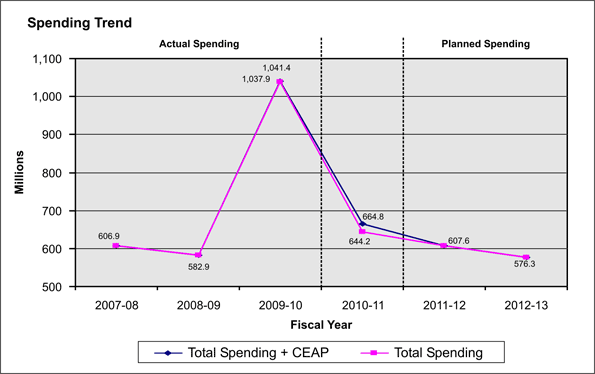
Canada's Economic Action Plan
In April 2009, the Agency received approval for Modernizing Federal Laboratories as part of Canada's Economic Action Plan announced in Budget 2009 to support the Canadian Science Centre for Human and Animal Health (CSCHAH), a Crown-owned facility in Winnipeg, Manitoba. The CSCHAH Shipping and Receiving Maintenance and Optimization Project has three basic components: a renovation to and expansion of existing interior space; an optimization of the existing space; and selective site alterations. Forecast spending for the project is $3.5M in 2009-10 with planned spending of $20.6M in 2010-11.
Voted and Statutory Items
This table shows the structure of the three Vote authorities appropriated to PHAC by Parliament via the Main Estimates, which are tabled in March each year and given final parliamentary approval in June. The amounts of the Votes change during the year when Parliament approves Supplementary Estimates; those changes often impact the following year as well. For example, during 2009-10 the Agency's operating expenditures (Vote 40) increased due to the introduction of the Human Pathogens and Toxins Initiative and the approval of funding for the installation of a new influenza vaccine fill line, among other things. These two changes also increased the Main Estimates for 2010-11 by $51.7M.
| Vote # or Statutory Item (S) | Truncated Vote or Statutory Wording | 2009-10 Main Estimates ($ M) |
2010-11 Main Estimates ($ M) |
|---|---|---|---|
| 40 | Operating expenditures | 352.7 | 406.2 |
| 45 | Capital expenditures | 9.6 | 36.8 |
| 50 | Grants and Contributions | 255.4 | 203.2 |
| (S) | Contributions to employee benefit plans | 30.3 | 31.8 |
| Total | 648.0 | 678.0 | |
Section II – Analysis of Program Activities
2.1 Strategic Outcome
The Agency's Strategic Outcome is: Canada is able to promote health, reduce health inequalities, and prevent and mitigate disease and injury. The following section describes the six Program Activities (PAs) through which the Agency works to achieve the Strategic Outcome, and for each, identifies the expected results, performance indicators and targets. This section also explains how the Agency plans to achieve the expected results and presents the financial and human resources that will be dedicated to each Program Activity.
Program Activity 1.1 – Science and Technology for Public Health

| Human Resources (FTEs) and Planned Spending ($ M) | |||||
|---|---|---|---|---|---|
| 2010-11 | 2011-12 | 2012-13 | |||
| FTEs | Planned Spending |
FTEs | Planned Spending |
FTEs | Planned Spending |
| 311 | 85.0 | 310 | 58.8 | 308 | 48.3 |
The main change from 2010-11 to 2011-12 is the reduction in spending due to the planned completion of the Modernizing Federal Laboratories initiative ($20.6M). The further decrease in 2012-13 is due to the planned completion of the project for the acquisition and retrofit of the JC Wilt Laboratory in Winnipeg.
| Expected Result | Performance Indicators | Targets |
|---|---|---|
| Public health decisions and interventions by public health officials are supported by research and timely and reliable reference service testing* | Percentage of accredited reference service tests* within turnaround time (TAT) | 80% |
| Percentage of reference service testing* performed under acceptable accreditation standards | 100% | |
| Research Publications Impact Factors | Determine baseline | |
| Reference Services External Reviews | Determine baseline |
* Reference testing performed by Agency laboratories includes specialized diagnostic testing, confirmatory testing and special testing to characterize disease-causing agents. Such reference testing is carried out both routinely and in response to emergency outbreaks.
PA Summary: This program deals with the development and application of leading edge national public health science and innovative tools, providing specialized diagnostic laboratory testing and reference services, and mobilizing Canadian scientific capacity and networks to enable Canada to improve public health and better respond to emerging health risks.
Canada's Economic Action Plan (CEAP): In support of the CEAP theme, “Creating the Economy of Tomorrow”, planned spending of $21.7 M for 2010-11 is targeted for renovation, optimization and expansion of existing laboratory space to address areas currently overcrowded and inadequate to support their functions. Through this funding, the Agency will be better positioned to meet the PA expected result and targets.
| CEAP Expected Results | CEAP Performance Indicators |
|---|---|
| Increased pathogens diagnosing capacity | # of specimens processed by period of time |
| Faster response to health emergency situations | Response time of diagnostic once sample is received |
| Job Creation | # of jobs created |
Planning Highlights: In order to achieve the expected result, the Agency will undertake the following activities:
- Provide timely and reliable testing that complies with reference testing requirements, which include ensuring the NML meets the ISO/IEC 17025 standards and maintains accreditation.
- Develop new methods to identify and evaluate the public health risk of emerging pathogens at the human–animal–environment interface.
- Develop innovative approaches for the prevention of infectious and chronic diseases based on the analysis of risk and on current knowledge about the human genome.
Benefits for Canadians: Canadians will benefit from timely and reliable public health decisions and interventions, and will be able to make personal health decisions that are based on advanced scientific knowledge.
Program Activity 1.2 – Surveillance and Population Health Assessment

| Human Resources (FTEs) and Planned Spending ($ M) | |||||
|---|---|---|---|---|---|
| 2010-11 | 2011-12 | 2012-13 | |||
| FTEs | Planned Spending |
FTEs | Planned Spending |
FTEs | Planned Spending |
| 347 | 58.3 | 347 | 58.8 | 333 | 57.2 |
Planned spending decreases by $1.6M from 2011-12 to 2012-13 mainly due to the sunsetting of one time funding to implement the recommendations made in the Report of the Independent Investigator into the 2008 Listeriosis Outbreak.
| Expected Result(s) | Performance Indicator(s) | Target(s) |
|---|---|---|
| Federal, provincial, territorial and local jurisdictions have the comprehensive, consistent and timely national picture of chronic and infectious diseases, risk factors, and determinants of health required to manage infectious and chronic diseases and risk factors to health | Percentage of key stakeholders indicating that Canada's surveillance and population health assessment provide the information required to manage infectious and chronic diseases | Determine baseline by March 31, 2011 |
PA Summary: This program facilitates ongoing, systematic analysis, use and sharing of routinely-collected data with and among provinces, territories, local health authorities, and other federal departments and agencies so that they can be in a better position to safeguard the health of Canadians. This program is necessary because of the continuous risk to the health of Canadians from emerging infectious and chronic diseases as well as other population health risk factors that are present in the population. The program is geared towards working with federal departments and agencies, other levels of government, health professionals, hospitals and laboratories across the country to facilitate the development of surveillance systems and the sharing of information.
Planning Highlights: In order to achieve the expected result, the Agency will undertake the following activities:
- Improve coordination of surveillance systems and programs within the Agency to ensure the timely and appropriate collection, use and dissemination of public health data and information internally and with our key partners in order to inform public health actions.
- Strengthen surveillance through the Agency's Surveillance Strategic Plan, and continue to address recommendations from the
 May 2008 Report of the Auditor General by implementing a structure and process to set surveillance system priorities, working with partners to identify roles and responsibilities in collaborative surveillance activities, implementing and maintaining mechanisms and tools for effective partnerships and sharing data and information and the identification and use of standardized tools for the implementation of ongoing performance assessment of surveillance.
May 2008 Report of the Auditor General by implementing a structure and process to set surveillance system priorities, working with partners to identify roles and responsibilities in collaborative surveillance activities, implementing and maintaining mechanisms and tools for effective partnerships and sharing data and information and the identification and use of standardized tools for the implementation of ongoing performance assessment of surveillance. - Strengthen Canadian Public Health Surveillance systems including those focused on vaccine safety, anti-microbial resistance, birth defects, tissue and organ safety, childhood cancer, tuberculosis, HIV/AIDS, sexually transmitted and bloodborne infections and risk behaviours. This will include enhancing the Canadian Notifiable Diseases Reporting System, expanding the Canadian Chronic Disease Surveillance System, and enhancing web-based query and analysis tools to improve information accessibility.
- Continue to gather, analyse, and report timely and accurate information on chronic and infectious diseases, risk factors, and determinants of health.
- Analyse evidence and prepare the annual Chief Public Health Officer Report on the State of Public Health in Canada for presentation to Parliament.
- Increase capability in assessing the health of the population by developing scenarios on complex public health issues, formalizing the governance of the Agency working group on Population Health Indicators and developing an Agency-wide process to advance, enhance and coordinate the interpretation and integration of population health data.
Benefits for Canadians: Emerging infectious and chronic diseases and risk factors within the population pose a threat to the health and safety of Canadians and to the Canadian economy. The Agency's initiatives will provide the timely and accurate information required by Canada's leaders and health systems to prepare for and respond to infectious disease outbreaks and address trends in the factors leading to chronic diseases. Surveillance information is used by all levels of government and non-governmental organizations to monitor the health of populations and contribute to policy, decision-making and programming.
Program Activity 1.3 – Public Health Preparedness and Capacity
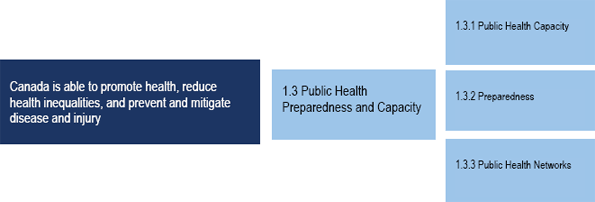
| Human Resources (FTEs) and Planned Spending ($ M) | |||||
|---|---|---|---|---|---|
| 2010-11 | 2011-12 | 2012-13 | |||
| FTEs | Planned Spending |
FTEs | Planned Spending |
FTEs | Planned Spending |
| 412 | 104.1 | 411 | 72.0 | 394 | 68.0 |
There is a decrease in planned spending from 2010-11 to 2011-12 mainly due to lower funding levels for the Influenza Vaccine Fill Line ($20M) and Vaccine Readiness and Clinical Trials ($11.2M). Planned spending decreases in 2012-13 are due to the anticipated completion of the Fill Line project.
| Expected Result(s) | Performance Indicator(s) | Target(s) |
|---|---|---|
| Canada has the capacity for public health interventions including emergency response | Percentage of capacity gaps bridged by stakeholders (i.e., federal, provincial, territorial, and local jurisdictions) | Determine baseline by March 31, 2011 |
PA Summary: This program increases Canada's public health preparedness and capacity by: providing tools, training and practices that enhance the capabilities of organizations and people who have a role in Canada's public health system; increasing public health human resource capacity; developing and maintaining Canada's ability to prepare for public health emergencies; and by establishing/maintaining networks both within and outside Canada. The program is necessary as public health skills, tools and networks are required for Canada to be able to keep Canadians healthy.
Planning Highlights: In order to achieve the expected result, the Agency will undertake the following activities:
- Strengthen national emergency preparedness and response capacity to address public health threats and mass gatherings through enhanced planning, processes and partnerships. This includes the review and revision of the
 Canadian Pandemic Influenza Plan, the Pandemic Antiviral Strategy, and the Canadian Pandemic Vaccine Strategy to incorporate experience acquired from responding to the H1N1 pandemic.
Canadian Pandemic Influenza Plan, the Pandemic Antiviral Strategy, and the Canadian Pandemic Vaccine Strategy to incorporate experience acquired from responding to the H1N1 pandemic. - Address Canada's need for public health skills by continuing to provide a
 competency-based suite of learning modules on core public health functions to help field epidemiologists to build public health capacity. This will be done by applying the experience and feedback gained from implementing the pilot module for Aboriginal public health professionals; revising the current catalogue of eleven Skills Modules to reflect the Core Competencies; increasing the catalogue by two additional Skills Modules; and developing and disseminating tools to support the use of Core Competencies for Public Health in Canada (Version 1.0).
competency-based suite of learning modules on core public health functions to help field epidemiologists to build public health capacity. This will be done by applying the experience and feedback gained from implementing the pilot module for Aboriginal public health professionals; revising the current catalogue of eleven Skills Modules to reflect the Core Competencies; increasing the catalogue by two additional Skills Modules; and developing and disseminating tools to support the use of Core Competencies for Public Health in Canada (Version 1.0). - Continue to support the evolution and adoption of electronic tools such as the
 Integrated Public Health Information System and
Integrated Public Health Information System and  Panorama which support case management and the sharing of information needed to rapidly and accurate identify and respond to disease outbreaks.
Panorama which support case management and the sharing of information needed to rapidly and accurate identify and respond to disease outbreaks. - Continue to provide secretariat and financial support to the
 Pan-Canadian Public Health Network and its expert groups for multilateral collaboration and agreements, including those on information sharing during emergencies.
Pan-Canadian Public Health Network and its expert groups for multilateral collaboration and agreements, including those on information sharing during emergencies.
Benefits for Canadians: These plans will provide increased capacity and assist public health practitioners in performing public health roles that are critical to the effective preparation for and response to public health events such as infectious disease outbreaks. These efforts will also enable stakeholders to exchange information and expertise so that they can become more effective in responding to the needs of their jurisdictions, including the ability of health care providers to quickly and accurately detect potential outbreaks. Timely and effective decision-making, coordination and action is critical to minimizing the effects of public health events on Canadians and to enable effective recovery for the general public, Agency personnel and government policy and programs.
Program Activity 1.4 – Health Promotion
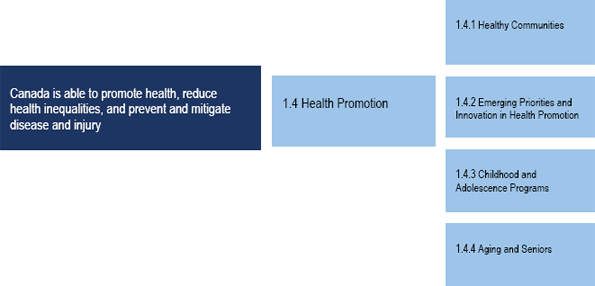
| Human Resources (FTEs) and Planned Spending ($ M) | |||||
|---|---|---|---|---|---|
| 2010-11 | 2011-12 | 2012-13 | |||
| FTEs | Planned Spending |
FTEs | Planned Spending |
FTEs | Planned Spending |
| 417 | 178.8 | 415 | 177.8 | 414 | 177.9 |
Planned spending for the Health Promotion program activity decreases slightly in 2011-12 due to the full implementation of budget reallocations made in the 2008 Strategic Review process.
| Expected Result(s) | Performance Indicator(s) | Target(s) |
|---|---|---|
| Canadians are supported in making choices that promote healthy human development | Number of external cross-government and cross-sectoral collaborations to address public health needs and common determinants of health and well-being | Determine baseline by March 31, 2010 |
| Number of health promotion programs, activities and initiatives supporting Canadians in making healthy choices | Determine baseline by March 31, 2010 |
PA Summary: This program provides leadership and support in promoting health and reducing health disparities among Canadians. It supports Canadians in making healthy choices throughout all life stages through initiatives focussed on, for example, child development, families, lifestyles, and aging. It also facilitates the conditions that support these choices by working with and through others to address factors and determinants that influence health, such as health literacy, food security, social support networks and the built environment.
Planning Highlights: In order to achieve the expected result, the Agency will undertake the following activities:
- Support the development of targeted, evidence-based health promotion strategies and interventions with a special focus on:
- Vulnerable children and families through collaboration and programs such as the
 Canada Prenatal Nutrition Program, the
Canada Prenatal Nutrition Program, the  Community Action Program for Children and the
Community Action Program for Children and the  Aboriginal Head Start in Urban and Northern Communities.
Aboriginal Head Start in Urban and Northern Communities. - Seniors, specifically with regard to
 healthy aging and elder abuse prevention, through such publications as an implementation and evaluation guide that will assist communities in establishing the age-friendly communities model consistently across Canada. The Agency will also work with Health Canada to identify promising approaches for addressing and preventing abuse in older adults in First Nations communities.
healthy aging and elder abuse prevention, through such publications as an implementation and evaluation guide that will assist communities in establishing the age-friendly communities model consistently across Canada. The Agency will also work with Health Canada to identify promising approaches for addressing and preventing abuse in older adults in First Nations communities.  Healthy living, as it relates to the promotion of physical activity and healthy eating and their relationship to healthy weights. This will be done by updating the physical activity guidelines for children and youth in Canada and developing a series of knowledge products, such as a healthy eating publication and a report on Aboriginal promising practices.
Healthy living, as it relates to the promotion of physical activity and healthy eating and their relationship to healthy weights. This will be done by updating the physical activity guidelines for children and youth in Canada and developing a series of knowledge products, such as a healthy eating publication and a report on Aboriginal promising practices.- The prevention of family violence through international, provincial, territorial and interdepartmental efforts. This includes working with partners within the
 Family Violence Initiative and the F/P/T Family Violence Prevention Working Group to clarify the links between family violence and health.
Family Violence Initiative and the F/P/T Family Violence Prevention Working Group to clarify the links between family violence and health.
- Vulnerable children and families through collaboration and programs such as the
- Develop a comprehensive and coordinated approach with health portfolio partners, other government departments and external organizations to mitigate the current prevalence of excess weight and obesity. This will be done through initiatives that support Canadians in the attainment and maintenance of healthy weights, including evidence-based resources and tools for practitioners and families.
- Lead initiatives such as the development and testing of tools designed to assess and improve policies and programs to better support Canadians with poorer health status by influencing the social, physical and economic determinants of health.
- Develop a framework on mental health (MH) promotion and mental illness (MI) prevention along with a MH impact assessment tool. The Agency will also fund innovative interventions at the community level focused on the MH of vulnerable populations to inform future policies and programs. Examples include the Resourceful Adolescent Program to build resilience and coping skills and promote positive MH among youth at risk, and Handle with Care, a MH promotion training program for child care practitioners in socially disadvantaged communities.
Benefits for Canadians: Health promotion is the process of enabling people to increase control over and improve their health based on understanding the determinants of health (such as healthy child development, gender, income, and literacy) and other factors. Health promotion activities support health education and positive changes in personal behaviours, and also focus on improving the social and physical environments that influence overall health and support the reduction of health inequalities. The Agency's health promotion work will positively affect the health of children, adolescents and seniors by providing leadership in the development of healthy public policies and community-based interventions in collaboration with partners including provinces and territories.
Program Activity 1.5 – Disease and Injury Prevention and Mitigation
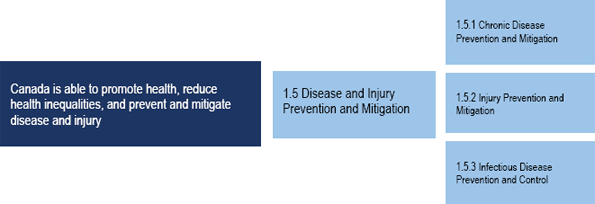
| Human Resources (FTEs) and Planned Spending ($ M) | |||||
|---|---|---|---|---|---|
| 2010-11 | 2011-12 | 2012-13 | |||
| FTEs | Planned Spending |
FTEs | Planned Spending |
FTEs | Planned Spending |
| 414 | 115.7 | 408 | 118.4 | 393 | 102.3 |
The increase in 2011-12 results from the beginning of a four-year initiative entitled “Targeted and Immediate Action on Lung and Neurological Diseases” that began in 2009-10, which is offset in part by the sunsetting of Agency initiatives under Canada's Clean Air Agenda. Spending decreases in 2012-13 due to the sunsetting of the Canadian HIV Vaccine Initiative as well as reduced funding levels for the 4th and final year of Targeted and Immediate Action on Lung and Neurological Diseases.
| Expected Result(s) | Performance Indicator(s) | Target(s) |
|---|---|---|
| Diseases and injury are prevented and mitigated | Rate of age-standardized new diagnoses of major diseases during a one-year period (i.e., incidence) | Determine baseline by March 31, 2010 |
PA Summary: This program develops and implements strategies, undertakes prevention initiatives, and supports stakeholders to prevent and mitigate chronic disease, injury, and prevent and control infectious disease. This work leads federal efforts and works collaboratively to mobilize domestic efforts. This program is necessary given the current and potential impact of injury and chronic and infectious disease on the health of Canadians and the sustainability of the Canadian health care system.
Planning Highlights: In order to achieve the expected result, the Agency will undertake the following activities:
- Engage and collaborate with other federal governments, provinces, territories, NGOs, professional groups and the private sector to examine the National Immunization Strategy (NIS) and develop options for strengthening the federal role as a follow-up to the
 NIS Interim Evaluation.
NIS Interim Evaluation. - Provide inter-sectoral leadership on interventions to prevent and control HIV and AIDS.
- Increase stakeholder knowledge and capacity regarding the prevention and control of infectious diseases in communities and settings where health care is provided through the development of guidelines, educational tools and status reports on HIV and AIDS in specific populations.
- Implement measures to address the recommendations made in the
 Report of the Independent Investigator into the 2008 Listeriosis Outbreak. This includes enhancing coordination and communication among federal, provincial and territorial partners in responding to multi-jurisdictional food-borne illness outbreaks by undertaking consultations to update and finalize
Report of the Independent Investigator into the 2008 Listeriosis Outbreak. This includes enhancing coordination and communication among federal, provincial and territorial partners in responding to multi-jurisdictional food-borne illness outbreaks by undertaking consultations to update and finalize  the Food-borne Illness Outbreak Response Protocol (FIORP) and developing a comprehensive national Food-borne Illness Incident Response Plan. The Agency will also develop an Incident Command Structure specifically tailored to food-borne illness outbreaks, and a Pilot Infectious Disease Impact and Response System adapted to climate change impacts.
the Food-borne Illness Outbreak Response Protocol (FIORP) and developing a comprehensive national Food-borne Illness Incident Response Plan. The Agency will also develop an Incident Command Structure specifically tailored to food-borne illness outbreaks, and a Pilot Infectious Disease Impact and Response System adapted to climate change impacts. - Conduct research, risk assessments and interventions and provide policy advice on public health issues linking humans to animals and the environment with a focus on pathogens arising from the food chain.
- Transfer knowledge developed in implementing health promotion and chronic disease prevention programs to partners and stakeholders through the
 Canadian Best Practices Portal to strengthen the adoption of effective prevention approaches. As well, led by the Agency, the
Canadian Best Practices Portal to strengthen the adoption of effective prevention approaches. As well, led by the Agency, the  Canadian Task Force on Preventive Health Care will develop chronic disease prevention guidelines for primary health care providers. This will enable Canadians to make better choices on how to protect their health and manage chronic conditions.
Canadian Task Force on Preventive Health Care will develop chronic disease prevention guidelines for primary health care providers. This will enable Canadians to make better choices on how to protect their health and manage chronic conditions. - Close knowledge gaps in the incidence, prevalence and risk factors of neurological diseases by initiating a
 four-year national study in collaboration with Neurological Health Charities Canada. This information will provide the foundation for future policy and program development and allow for quality investments by governments and health charities.
four-year national study in collaboration with Neurological Health Charities Canada. This information will provide the foundation for future policy and program development and allow for quality investments by governments and health charities. - Improve the knowledge of Canadians on respiratory health so that they can lower their risk of developing lung disease and better manage their
 lung health. As a federal commitment to the National Lung Health Framework, the Agency will work with the
lung health. As a federal commitment to the National Lung Health Framework, the Agency will work with the  Canadian Lung Association to develop public awareness initiatives and information toolkits.
Canadian Lung Association to develop public awareness initiatives and information toolkits. - Provide health professionals and Canadians with information and tools to prevent and manage hypertension (high blood pressure) through support to the
 Canadian Hypertension Education Program, given that hypertension is one of the most important risk factors for cardiovascular diseases and stroke.
Canadian Hypertension Education Program, given that hypertension is one of the most important risk factors for cardiovascular diseases and stroke. - Gather and analyze data on the rates, trends and patterns of injuries in Canada. The resulting information will be shared widely among partners and stakeholders to support policies, practices and programs for injury prevention and control.
Benefits for Canadians: Canada's ability to prevent and manage diseases and injuries will be enhanced. There will be a reduction in the burden of illness due to health care associated infections. Enhanced national food-borne illness outbreak preparedness and better protection of the health of Canadians will contribute to the protection of the health and well being of Canadians. Policies, programs and interventions will be enhanced by providing public health practitioners with data, analysis, guidelines, web tools and technical advice so as to reduce the burden of disease and injury in Canada.
Program Activity 1.6 – Regulatory Enforcement and Emergency Response
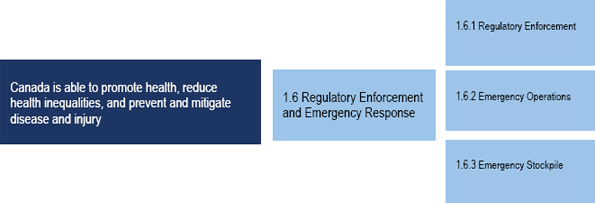
| Human Resources (FTEs) and Planned Spending ($ M) | |||||
|---|---|---|---|---|---|
| 2010-11 | 2011-12 | 2012-13 | |||
| FTEs | Planned Spending |
FTEs | Planned Spending |
FTEs | Planned Spending |
| 178 | 29.5 | 184 | 29.6 | 175 | 28.5 |
Planned spending decreases by 1.1M from 2011-12 to 2012-13 mainly due to the sunsetting of the funding to implement the recommendations made in the Report of the Independent Investigator into the 2008 Listeriosis Outbreak.
| Expected Result(s) | Performance Indicator(s) | Target(s) |
|---|---|---|
| Canada responds to public health emergencies in a timely manner | Respond to an emergency situation within 24 hours | 100% |
PA Summary: This program deals with providing regulatory enforcement; managing the Health Portfolio Operations Centers, the National Emergency Stockpile System and the Health Emergency Response Teams; and responding to national and international public health emergencies including natural disasters, serious outbreaks of infectious disease, such as pandemic influenza, or human caused emergencies.
Planning Highlights: In order to achieve the expected result, the Agency will undertake the following activities:
- Integrate experience acquired from the Agency's response to the H1N1 flu pandemic to improve leadership and coordination.
- Improve the 24 hours/7 days a week capacity of the
 Emergency Operations Centre, the
Emergency Operations Centre, the  Global Public Health Intelligence Network and quarantine border health security in preparation for full compliance with
Global Public Health Intelligence Network and quarantine border health security in preparation for full compliance with  International Health Regulations by June 2012.
International Health Regulations by June 2012. - Develop a policy and regulatory framework under the
 Human Pathogens and Toxins Act (HPTA) through public consultation and engagement, and enforce the Human Pathogens Importation Regulations through compliance inspection and permit issuing processes to manage the licensing of Canadian laboratories that handle human pathogens and toxins. In addition, laboratories will be enhancing their laboratory systems and practices to ensure compliance with the HPTA.
Human Pathogens and Toxins Act (HPTA) through public consultation and engagement, and enforce the Human Pathogens Importation Regulations through compliance inspection and permit issuing processes to manage the licensing of Canadian laboratories that handle human pathogens and toxins. In addition, laboratories will be enhancing their laboratory systems and practices to ensure compliance with the HPTA. - Continue to develop a national reserve of health care professionals to meet the needs of the Agency, provinces and territories to respond to outbreaks. This complements the existing Health Emergency Response Team, which has been equipped and trained to respond to domestic medical emergencies that require a self-sustaining medical team.
- Continue to operate the
 National Emergency Stockpile System and deploy the Microbiological Emergency Response Team* mobile laboratories, as required, to respond to infectious disease emergencies and bioterrorism incidents in Canada or around the world.
National Emergency Stockpile System and deploy the Microbiological Emergency Response Team* mobile laboratories, as required, to respond to infectious disease emergencies and bioterrorism incidents in Canada or around the world.
* The Microbiological Emergency Response Team (MERT) is a mobile laboratory capacity that deploys on short notice to assist around the world in public health crises. Staffed by National Microbiology Lab, and working closely with the ![]() WHO, the mobile lab-truck and lab-trailer can be deployed prior to major international events to identify and process potential Risk Group 3 and 4 pathogens and enhance event security. The MERT and its mobile lab-truck and lab-trailer are part of the
WHO, the mobile lab-truck and lab-trailer can be deployed prior to major international events to identify and process potential Risk Group 3 and 4 pathogens and enhance event security. The MERT and its mobile lab-truck and lab-trailer are part of the ![]() RCMP-led Integrated Security Unit deployed for the 2010 Vancouver Olympics. MERT also trains staff in outbreak response and develops new diagnostic tests that can detect emerging infectious agents rapidly and efficiently.
RCMP-led Integrated Security Unit deployed for the 2010 Vancouver Olympics. MERT also trains staff in outbreak response and develops new diagnostic tests that can detect emerging infectious agents rapidly and efficiently.
Benefits for Canadians: Regulatory enforcement and emergency response will provide benefits such as increased protection against the risks posed by human pathogens and toxins through consistent, safe laboratory handling procedures and transportation measures. In addition, there will be increased protection from infectious diseases for travellers at ports of entry to and from Canada and for participants in mass gatherings.
Program Activity 2.1 – Internal Services
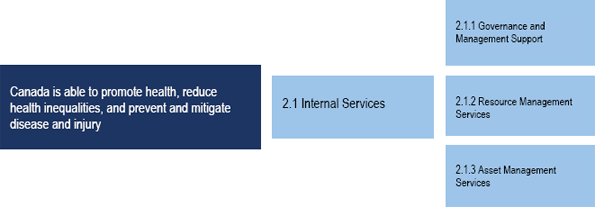
| Human Resources (FTEs) and Planned Spending ($ M) | |||||
|---|---|---|---|---|---|
| 2010-11 | 2011-12 | 2012-13 | |||
| FTEs | Planned Spending |
FTEs | Planned Spending |
FTEs | Planned Spending |
| 511 | 93.4 | 508 | 92.2 | 518 | 94.1 |
| Expected Result(s) |
Performance Indicator(s) |
Target(s) |
|---|---|---|
| The communications, service operations and programs of the Agency comply with applicable laws, regulations, policies and/or plans and meet the diverse needs of the public | Compliance with the statutory time requirements of the Access to Information Act and Privacy Act (ATIP)* | A Rating (95% and above) |
| Compliance with the Government of Canada Communications Policy | 100% | |
| Compliance with the Government of Canada Official Languages Act | 100% | |
| Strategic allocation and prudent use of resources among programs, processes and services | Compliance with the Government of Canada Employment Equity Act** | Aboriginal People - 3.3% Persons with Disabilities – 4.3% Visible Minorities – exceed 12.9% Women – 61.8% |
| % growth of critical shortage occupational groups*** | Personnel Administration (PE) - 29 Employees Medicine (MD) - 46 Employees Economics and Social Sciences (EC) - 612 Employees Engineering and Scientific Support (EG) - 261 Employees Scientific Research (SE) - 59 Employees |
|
| % Year-end Agency variance of planned versus actual expenditures | 5% variance or less | |
| Information technology and management that supports government priorities and program and service delivery | Compliance with Government of Canada Common Look and Feel (CLF) 2.0 | 100% |
| Assets are acquired and managed in a sustainable and financially responsible manner, throughout their lifecycle, to support the cost-effective and efficient delivery of government programs and services | % of major capital assets with completed asset condition reports**** | 100% |
Note: * Office of the Information Commissioners rating; ** A workforce representative of Workforce Availability estimates based on the 2006 Census; *** Increase or maintain workforce availability estimates based on April 1, 2009 baseline numbers (Indeterminates and Terms >3 months); **** Assets with an initial acquisition cost of $50,000 or more, excluding real property and related infrastructure.
PA Summary: Internal services support the Agency's strategic outcome and all six PA's. Internal services are groups of related activities and resources that are administered to support the needs of programs and other corporate obligations of an organization. These groups are Management and Oversight Services, Communications Services, Legal Services, Human Resources Management Services, Financial Management Services, Information Management Services, Information Technology Services, Real Property Services, Materiel Services, Acquisition Services, and Travel and Other Administrative Services. Internal services include only those activities and resources that apply across the Agency and not those provided specifically to a program.
Planning Highlights: In order to achieve the expected results, the Agency will undertake the following activities:
- Develop a strategic relations framework to guide the Agency in working effectively with stakeholders to advance policy development.
- Establish and implement an Agency HR Management Framework over the next three-year planning horizon to support the Deputy Head in the people management aspects of the organization in accordance with the Public Service Modernization Act and the recent refocusing of central agency responsibilities related to strategic human resources management.
- Renew and implement the Agency's Values and Ethics Plan.
- Continue to implement and improve on the Agency's Performance Measurement Framework by reviewing and assessing all expected results, performance indicators and targets and developing a data collection strategy.
- Continue to implement the requirements of the Agency's Integrated Risk Management Standard with a particular focus on the development and implementation of risk management policies, guidelines, procedures and tools.
- Implement the Agency's five-year Evaluation Plan and launch an Agency-specific policy suite on evaluation that promotes an evaluative culture and supports policy and program planning and improvement, expenditure management and public reporting.
- Enhance project management capacity and implement processes to enhance governance of the Agency's 5-year Investment Plan.
- Continue to implement a Materiel Management Framework that supports sound governance of Agency assets and develop an annual Procurement Plan.
Benefits for Canadians: Canadians will have the information they need to make well-informed decisions to protect their health and the health of their families. Enhanced asset management, sound investment planning and early identification of potential needs will enable the Agency to be better prepared to respond to health emergencies. As well, the Agency will demonstrate sound resource management and procurement practices based on value for money, transparency, open access, competition and prudence.
Section III – Supplementary Information
3.1 Financial Highlights
The future-oriented financial highlights presented in this report provide a general overview of the Agency's financial position and operations. ![]() Future-oriented Financial Statements are prepared on an accrual basis to strengthen accountability and improve transparency and financial management.
Future-oriented Financial Statements are prepared on an accrual basis to strengthen accountability and improve transparency and financial management.
| ($ M) | Forecast 2010-11 |
Revised
Forecast 2009-10 |
Actual 2008-09 |
|---|---|---|---|
| Expenses | 651.0 | 1,046.5 | 603.4 |
| Revenues | 0.3 | 0.3 | 0.3 |
| Net Cost of Operations | 650.7 | 1,046.2 | 603.1 |
The chart below outlines the Agency's Future-oriented Net Costs of Operations for 2010-11 by Program Activity:
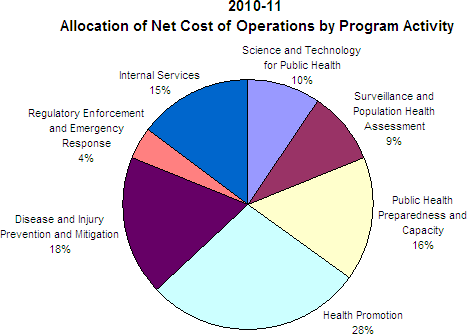
The difference between the future-oriented net cost of operations and planned spending is due to the following two adjustments:
| ($ M) | Forecast 2010-11 |
Revised
Forecast 2009-10 |
Actual 2008-09 |
|---|---|---|---|
| Net Cost of Operations | 650.7 | 1,046.2 | 603.1 |
| Adjustments for items affecting net cost of operations but not affecting appropriation | (24.8) | (26.7) | (29.1) |
| Adjustments for items not affecting net cost of operations but affecting appropriation | 38.9 | 21.9 | 8.9 |
| Planned Spending/Current year appropriations used | 664.8 | 1,041.4 | 582.9 |
3.2 List of Tables
All electronic supplementary information tables found in the 2010-11 Report on Plans and Priorities can be found on the Treasury Board of Canada Secretariat's website at ![]() http://www.tbs-sct.gc.ca/rpp/2010-2011/info/info-eng.asp.
http://www.tbs-sct.gc.ca/rpp/2010-2011/info/info-eng.asp.
- Details on Transfer Payment Programs (TPPs)
- Green Procurement
- Horizontal Initiatives
- Internal Audits and Evaluations
- Sources of Respendable and Non-Respendable Revenue
- Summary of Capital Spending by Program Activity
The following table is located on the Agency's Web site: